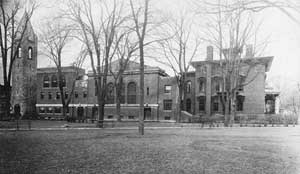
El condado de Tompkins está dividido por el lago Cayuga, el segundo más largo de los lagos Finger creados por los glaciares. El lago, de 435 pies de profundidad en su núcleo, con sus cabeceras en el extremo sur, es alimentado por arroyos que se abren paso a través de gargantas cortadas en el esquisto y la piedra caliza subyacentes que forman la base geológica del condado. El condado hoy en día consta de 476.1 millas cuadradas; el extremo sur terreno accidentado con la colina de Connecticut que alcanza 2,095.97 pies. La porción norte presenta un terreno más suave y fértil.

cortesía de The History Center
El desarrollo del ferrocarril unió el condado de Tompkins con los mercados y destinos comenzando en 1832 con el ferrocarril Ithaca-Owego tirado por caballos. En los años 1870, había cuatro líneas ferroviarias principales que atravesaban Ítaca. Los viajes lacustres comenzaron en 1823 y continuaron hasta el siglo XX.
Ithaca College abrió sus puertas en el centro de Ithaca en 1892, al principio como una academia de música, y luego se expandió a varios campos. La universidad se trasladó a South Hill en 1969. Las industrias importantes en el condado incluyen la Ithaca Gun Company, la compañía de aviones Thomas-Morse y la Groton Iron Bridge Company, todas las cuales ya no están. Durante una década, a partir de 1914, se hicieron películas en Ítaca.

Population growth in the twentieth century continued only slowly, although the university from 1885 increased yearly in size bringing faculty, hiring local staff, and drawing students in ever-growing numbers. In 1910 there were 33,647 residents in the county. The increase thereafter was slight until 1940 when the total population of Tompkins County was 42,340. In the next ten years the overall population jumped by more than 16,000 residents to 59,122, with the major gain occurring in Ithaca, reflecting the dramatic growth of Cornell University following the second World War. An additional jump by 10,000 residents between 1960 and 1970 brought the county population to 77,064. That decade’s figures reveal a shift in living patterns with a major increase in the Town of Ithaca, especially in the northeast portion and in the areas adjacent to Cornell.
By the 2000 federal census, the population of Tompkins County was 96,501. The ethnic composition of the county had also changed. There had been a major influx of Irish immigrants in the 1830s and ‘40s. Late in the nineteenth-century, Italians and some identified as Hungarians began to arrive. Early in the twentieth century newcomers included Italians, Hungarians, Greeks, and Finns. In 1900 there were two Chinese listed in the Federal Census. By 2000 the County housed a diversified Asian community along with Hispanics, Russians, and a small but significant contingent of Tibetans who founded a monastery, first on North Aurora Street and in 2008 along the Danby Road (route 96 south). The student population at Cornell is nearly twenty thousand.
The major business of the county is education, with Cornell, Ithaca College, the Tompkins Cortland Community College, and six public school systems plus several private schools and the Community School of Music and Art (CSMA). Agriculture continues to be important; there is an active Farmer’s Market featuring food grown in the area. Tompkins County also attracts tourists to its Discovery Trail of important museums: the Museum of the Earth, the Sciencenter, the Johnson Art Museum, the History Center. More than sixty cultural organizations, including historical societies, drama companies, musical groups of all kinds, dance companies and an orchestra and opera society flourish. There is a stunning cycle of events each year that include the Ithaca Festival, which occurs the first weekend of June, the Grassroots Festival each summer, Light in Winter each January, and an Art Trail open all year long with featured weekend events in the spring and fall.

Hay un importante complejo de negocios adyacente al aeropuerto del condado. Más de 80 compañías del condado están aquí porque sus fundadores estudiaron o mostraron en la universidad.
Tradicionalmente, el condado, fuera de la ciudad de Ithaca, votaba por los republicanos. Con el aumento de la población luego de 1950, el núcleo demócrata aumentó y en 1993 la Junta del Condado por primera vez tuvo una mayoría demócrata.
El condado es atendido diariamente por The Ithaca Journal, que comenzó en 1814, The [Cornell] Daily Sun [1880], y The Ithaca Times, una publicación semanal de noticias.
La historia del condado fue tratada por primera vez en H. Hurd, History of Chemung, Schuyler, Tioga and Tompkins Counties, Nueva York (Filadelfia, 1879) y en John Selkreg, Landmarks of Tompkins County (Syracuse, 1894). Horace King escribió un ensayo sobre Ítaca en 1847, H. C. Goodwin publicó Ithaca tal como era, e Ítaca tal como es, en 1853, y Henry Abt publicó Ítaca, en 1926. Los tratamientos recientes incluyen Carol Kammen, Peopling of Tompkins County: A Social History (Interlaken, 1985) y Jane M. Dieckmann, A Short History of Tompkins County (Ithaca, 1986). También es útil W. Glenn Norris, El origen de los nombres de lugares en el condado de Tompkins (Ithaca, 1951) o los nombres de lugares actualizados del condado de Tompkins, publicados en 2003 por los historiadores municipales del condado de Tompkins. También está The Towns of Tompkins County, editado por Jane M. Dieckmann (Ithaca, 1998). Ver también The Architectural Heritage of Tompkins County con fotografías de Richard Corth, publicado en 2002.
